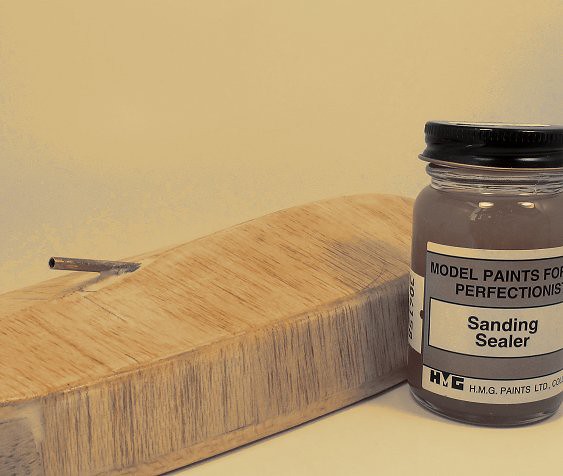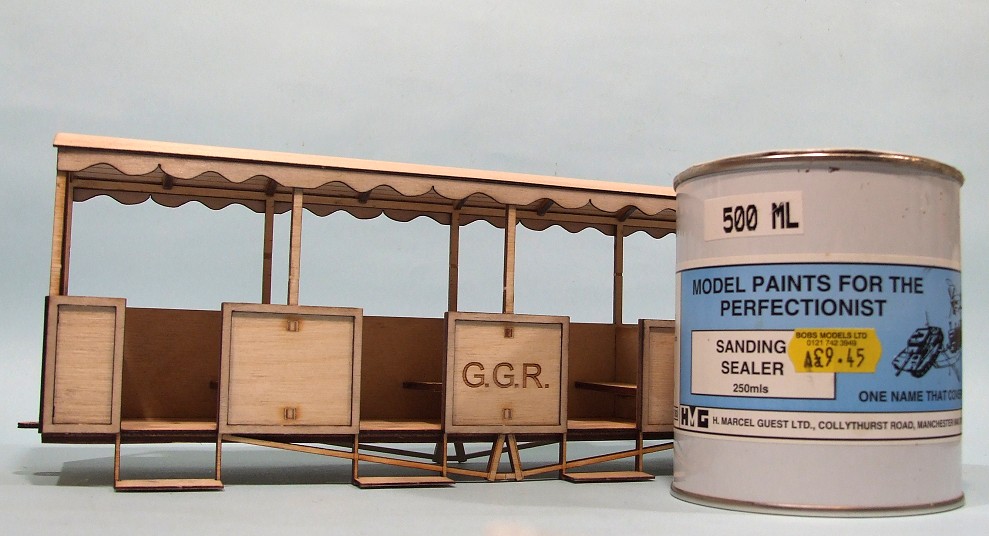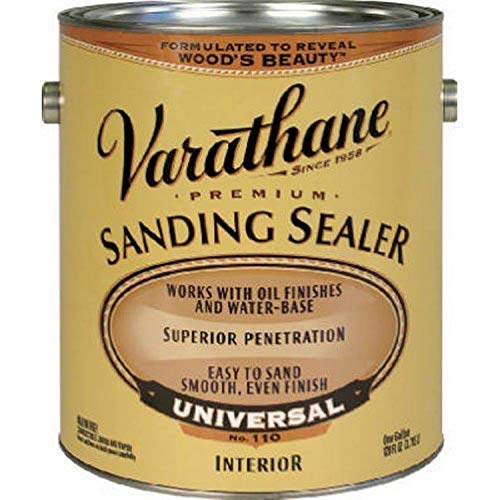A client was shown the list of products to be purchased. In his bid to cut cost, he suggested we rule out the wood sealer. We had to do some convincing before he approved of the purchase of the sanding sealer.
Considering this, it is important you know the relevance of this product. What does sanding sealer do?
As woodworkers, we cannot overemphasize the importance of sanding sealers. If you show us well-finished woodwork, we will show you how the sanding sealer might have been appropriately used. These products contain items that make your final wood piece the best it can be.

Many people question if the use of this product is a necessity. Sometimes, woodworkers need to cut cost and strike out the less essential procedures. So, let’s cut to the chase
What impact does sanding sealer have on wood? Is using sanding sealer a necessity?
In our bid to answer these questions, we will enunciate the relevance of using these sealers. As a woodworker, the disadvantages of steering clear of this product will be highlighted and discussed at length.
Furthermore, the appropriate steps to be taken before, during, and after using the sanding sealer will be explained.
If you prefer a visual explanation of this subject, below is a detailed and helpful video.
Video: What Does Sanding Sealer Do (Are They of Any Use?)
What Does Sanding Sealer Do?
Sanding sealers help fill up wood pores, acts as a base coat, enable you to paint on time, and it makes the sanding process easy. If used, the sanding sealer is often applied before the topcoat is used. Majorly, the properties of these products help fill up loopholes and porous parts of the wood. This is achievable given how the soupy properties occupy the vacant pores in the wood. The use of this product helps wood makers get the best topcoat possible.
Most woodworkers know the intended wood piece is not complete until it is polished. Polishing your wood involves applying the topcoat to the carved piece. It is the last piece of the puzzle for the ideal woodwork.
However, it is better if every error is rectified before this period. Correcting flaws after the topcoat is applied can be damaging to the woodwork.
What are the Benefits of Using a Sanding Sealer?
The benefits of a sanding sealer include the following:
1. It is economical
2. Saves your time
3. Makes the sanding process easy
4. Can be used on a lot of wood surface
5. Allows for proper bonding between the wood and topcoat
6. Deals well with wood pores
The advantage of using Sanding Sealers affects both the users and the woodwork. These products make the work of a woodworker easier. It also helps you achieve the best possible wood piece. Some of these benefits include:
Video: Why Use a Sanding Sealer
The video below explains the essence of sanding sealers.
Cuts Cost
Is using a sanding sealer expensive?
Using a sanding sealer is not expensive if you take account of what it does. Rather, using a sanding sealer turn out as profitable and economical. This is primarily because it prevents accidents and saves time.
First, it saves you from accidents caused by the previous sanding. Without the sanding sealer, scraps of wood can stick to the adhesive parts of the sandpaper. This can leave scratches on the newly sanded item. However, with this item used, the sanding is smooth, safe, clear, and uninterrupted.
It is rather ironic how people avoid these products because of the cost. However, one of the benefits of using this product is that it saves money depending on the woodwork intended.
If you need to get a third product for your work, you should know sanding sealers cost less than the topcoat.
Time is Money
How does the sanding sealer make sanding easy?
The sanding sealer makes sanding easier by allowing the feel of the sandpaper to go uninterrupted. Its lubricating effect makes sure the wood’s raised grains do not make sanding difficult by gumming up your sandpaper.
This in turn allows you to do so much in less time and easily. Without the sanding sealer, woodworkers also have to battle the porous parts of the wood, as well as the slightly uneven surface. This process could take a while, delaying your desire to apply the final topcoat in a good time.
However, the sanding sealer cannot be used on every kind of wood. Items such as the polyurethane will do well without the sanding sealer. But often, sanding sealers are great for wood surfaces.
Also, applying the sanding sealer helps your wood dry faster than the conventional time. The properties of these products contain catalysts that aid this process.
Does the sanding sealer save time?
The sanding sealer saves the woodworker time that would be spent on drying the wood. Before applying the topcoat, it is important that the surface is dry enough. Usually, without the sanding sealer, the process can take hours and even over a day in extreme situations. However, with the aid of the sanding sealer, this can be as fast as 1 hour.
Thanks to the sanding sealer, the delay that can stretch through a whole day, can simply be over in over one hour.
Considering this, the lure of doing more than usual could be a reason to use the sanding sealer. However, this solely isn’t a good enough reason for using the product. Why else should you consider using this product?
The Variance is Amazing
This product can be applied to various kinds of wood. Furthermore, it can have great effects on various conditions of wood as well.
For instance, the sanding sealer can be applied to naked raw wood. It can be used to hasten adhesion on existing surfaces, as well as painted wood, among others. Just being applied as the initial coating can make a world of difference for these woodworks.
Proper Bonding Between Topcoat and Wood
Some kinds of wood contain very oily components in them. This isn’t meant to be a problem except for the effects on the coat. The oily constituents make the wood slippery, making the required grip between the wood and coat hard to achieve.
The sanding sealer helps to resolve this problem. This is because of the lubricating effects it possesses. It washes the oily constituents to a reasonable extent. This allows the wood and coat to attach easily without complications.
Best Deals with Wood Pores
Some kinds of wood have more pores (holes) than others. This can be caused by factors ranging from natural to environmental. For example, insects such as termites can be responsible for these pores.
Can sanding sealer help fill wood pores?
Sanding sealers have properties that can help fillup wood pores. However, when the pores are too big or much, you should rather opt for a grain filler. This is the best item for resolving very severe wood pores.
Sometimes, the size and depth of the pores make sanding (alone) a bad option. Considering this, using the sanding sealer is a great option that helps to fill up this hole. The soapy constituents of these products create the appropriate bond with the entire wood.
Ultimately, this allows you to achieve that glossy looking item you’ve always desired. Other options for resolving the pores include the use of pore fillers.
What should you look out for when buying a grain filler?
Before buying a grain filler, lookout for a product that is able to bond well with the wood. When you are certain the filler meets this criterion, you’ll have yourself a product that will help the sanding process.
How Do You Use a Sanding Sealer?
To use a sanding sealer, apply the content evenly across all parts of the wood surface. Next, allow the content dry for about 6 – 10 minutes. Afterward, you can begin to sand easily as the lubricating content will help against the raised grain, as well as wood scraps sticking to the sandpaper.
If you would use a sanding sealer, do not use any more than 2 additional coats. If you would not stick to one, do not go any more than two coats. This is because the sanding sealer acts as a basecoat on its own. Using more than two coats can affect the general outcome.
After applying the sanding sealer, how long should you wait before applying topcoat?
After applying the sanding sealer, do not be in a hurry to apply the topcoat. You should wait for about 12 – 30 minutes before applying it. Especially under the right conditions, sanding sealers hasten the drying process, however, you should give the wood the required time to dry up. At 30 minutes, the work is extremely dry and that is alright for the wood. This is especially in preparation for the topcoat.

Do You Use Sanding Sealer Before or After Stain?
Usually, you are supposed to stain before using a sanding sealer. The aftermath of staining is a reason you should seal afterward. There is a chance that staining could result in bleeding. In order to prevent this, you should seal the porous parts after the staining procedure.
However, depending on some reasons, some woodworkers may do it the other way around.
The idea behind sealing is doing away with the porous parts of the wood. On the other hand, staining takes advantage of the porous spaces that sealing seals up. In that regard, the ideal thing is to stain first and seal afterward.
Can You Use Sanding Sealer as a Finish?
You should not use a sanding sealer as a finish. Rather, the sanding sealer is designed to act as a base coat that aids the sanding process, as well as enables proper bonding between the wood and topcoat. In other words, sanding sealers are not designed to act as a finish.
They are constructed to be used over the stained wood and before the finish coat is applied. Unlike the polyurethane, the properties of the sealer are not formidable enough to deal with atmospheric conditions.
Also, properties such as the dewaxed shellac can act well as a sanding sealer. However, the dewaxed shellac should not be applied as the finish coat. These items should only be retained as the base coat for the final finish coat.
How Long Does Sanding Sealer Take to Dry?
After applying the sanding sealer, the wood should be dry enough for sanding in about 6 – 10 minutes. For applying the topcoat, the wood should be dry enough in about 12 – 30 minutes.
This is one of the high points of using the sanding sealer. The time it takes to dry the wood is second to none.
This is dependent on the product brand, quality, and largely, the condition of the wood. Without the sealer, the process can extend as far as 24 hours and more.
Do You Need to Use the Sanding Sealer?
You do not have to use the sanding sealer. In fact, some items are better without the use of the sanding sealer. An example is polyurethane. However, on most wood surfaces, the use of the sanding sealer benefits both the wood and woodworker. Some of the advantages include the ease in sanding, protecting the sandpaper, dealing with wood pores, bonding with topcoat, among others.
One of the greatest advantages of this product is how it helps to deal with porous openings on wood surfaces. These opening can be very big, obstructive, and appalling. Coupled with the ease and timeliness it affords, these are the greatest benefit of using the sanding sealer.
However, it is important to know you can do without these products. Some experienced woodworkers do away with these products and still make great pieces. Be that as it may, there is no doubt that sanding sealers are a very great aid in getting that dream finish for your wood.
Another reason the sanding sealers may not be used is the size of the wood pores. Some kinds of wood have very large-sized pores that are difficult to fill up. In a moist humid environment, this could also be caused by insects such as termites.
Using the sealers can be uneconomical in this regard. This is considering the amount of sanding sealer content that will be required to fill up the pores.
In such cases, some experienced woodworkers use alternatives such as pore fillers. These workers use the pore fillers to fill the openings, making it at par with the other parts for eventual sanding.
However, these fillers should be items that bond easily with the wood, allowing for the final application of the topcoat.
Conclusion
We have gone through the benefits, clarifications, and application of the sanding sealer. In this regard, we hope that you clearly understand it is a great choice for a great wood finish. We have also identified the possible reasons why sanding sealers would not be an option.
Check out these other in-depth articles…
- How To Use a Sander – measures and precautions for sander
- What Is a Da Sander – Peculiarities and Appropriate Use
- How to Use a Drum Sander – Advantages and Peculiarities
- How to Sand Hardwood Floors with Orbital Sander – A Guide
- What Is an Orbital Sander – How do they Work
- How Long to Wait Before Wet Sanding Clear Coat – Timely Details
What Does Sanding Sealer Do – Related Frequently Asked Questions
Do You Need to Use Sanding Sealer Before Polyurethane?
You do not need to use the sealing sealer before polyurethane. Polyurethane is not hard to sand, so there is little or no need for sanding sealers. Another reason is that they do not bond well enough. Sanding sealers work well with most wood items but there are few exceptions as Polyurethane is one of such.
The polyurethane material does not bond well with sanding sealers and this is why the use of sealers on it is usually discouraged. However, many other wood materials are good with the sanding sealer.
What Is the Difference between a Sealer and a Primer?
A sealer is a coat that is used to plaster and seal wood, preventing the wood’s exterior from suckling varnish or paint. It is mostly used as a base coat. However, some are designed to function without coating.
The primer is the initial coat used when painting. It is designed to help the subsequent coats and wood surface bond well. Often, primers are made with pigments that help the subsequent coat keep their color. Given the importance of these items, woodworkers need to purchase quality items. One capable of carrying out these roles.
Is Sanding Sealer Waterproof?
Sanding sealers are not waterproof. When used appropriately, sanding sealers can help the wood deal with moisture. This is as a result of the chemical properties used to make them. Also, acting as a base coat, the other subsequent coats protect the wood from coming in contact with moisture.
However, you should not treat the sanding sealer as water-resistant. This is because it can only protect the wood from moisture for a while. So, do not expose your wood surfaces to moisture. If you cannot avoid this, use water-resistant clothing over them.
Does sanding sealer fill grain?
Sanding sealers can only do a little bit of filling grain. If you intend to fill the pores in the wood surface, a good grain filler will be better for the job. The sanding sealer can do a bit, but it is not primarily designed for this purpose. It is supposed to act as a base coat, allowing the needed adhesion between the wood exterior and subsequent coats. So, you should opt for a grain filler if you want to fill the wood pores.
Do you need to seal stain?
You need to seal stain with a topcoat because it helps the wood remain intact in the long run. Although the stain is great at making the wood look good and strong, it does not contain properties to protect the wood in the long run. As a result, you should use a good topcoat over the stain. This will protect the wooden item from moisture, humidity, and other harsh conditions. This is important in ensuring your wooden item retains its life span.
How long after staining can you seal?
The timing between staining and sealing is between 1 to 2 days. The waiting time depends on the product. This is because the chemical compositions are different among the various brands. You can even choose to allow it dry for 3 days. This is just so that you are careful. You do not want to work on a wet surface, ruining the hours of hard work you had put into the job.
To be on the safe side, a little patience will suffice here.






